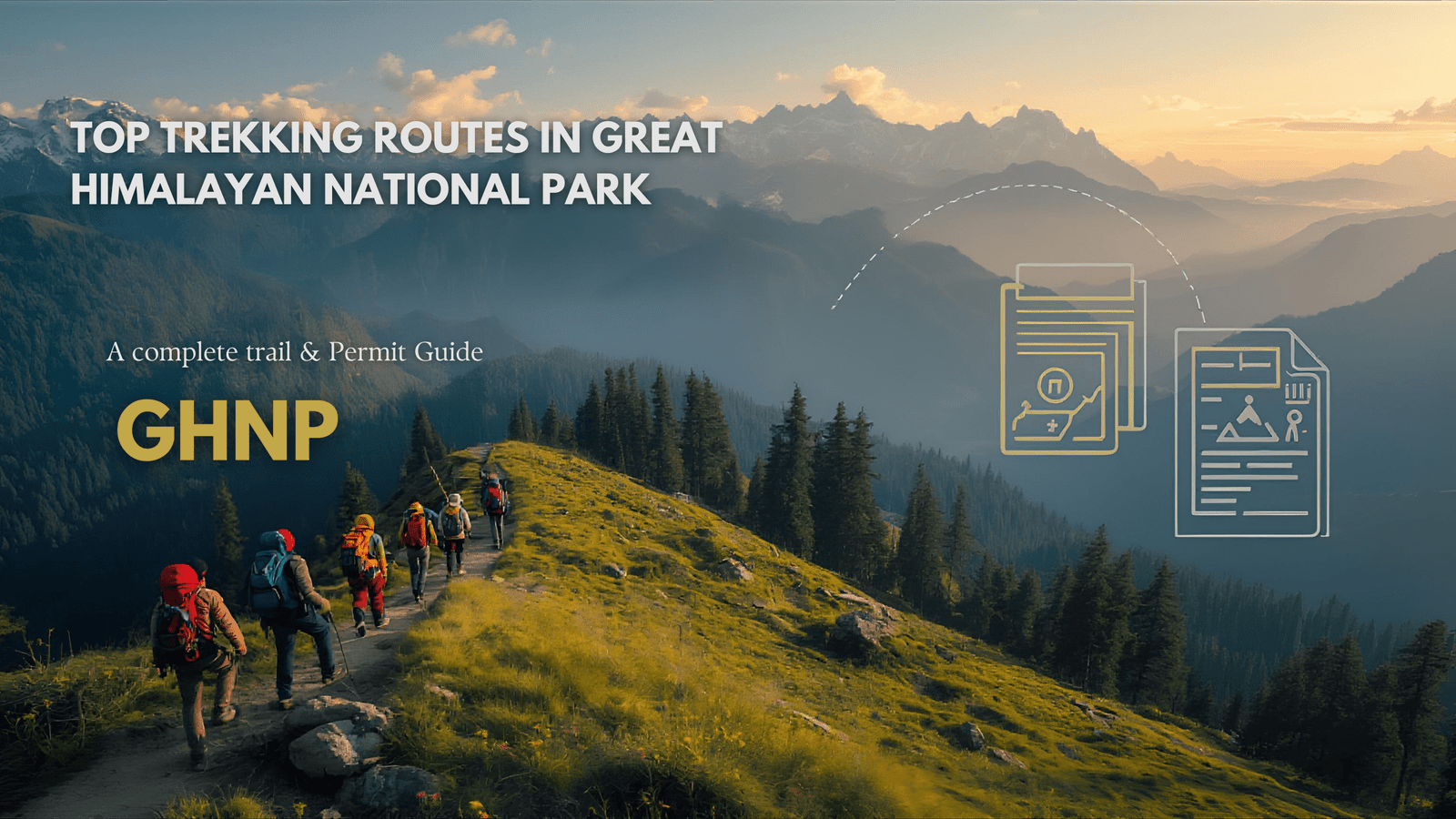Tucked away in the Garhwal Himalayas of Uttarakhand, Dayara Bugyal stands as one of India’s most spectacular high-altitude meadows. This pristine alpine destination transforms dramatically with each passing season, offering trekkers unique experiences throughout the year. Whether you’re drawn to snow-covered winter landscapes, vibrant spring blooms, monsoon greenery, or autumn’s golden hues, understanding what each season brings will help you plan the perfect adventure.
The Dayara Bugyal trek in Uttarakhand has gained immense popularity among both novice and experienced trekkers due to its moderate difficulty level and breathtaking panoramic views of Himalayan giants like Bandarpunch, Gangotri massif, and Draupadi Ka Danda. Starting from the charming village of Barsu in Uttarkashi district, this trek takes you through dense oak and rhododendron forests before opening into vast meadows that stretch as far as the eye can see.
Choosing the right time for your visit can make or break your trekking experience. Each season paints Dayara Bugyal with a different palette and presents its own set of challenges and rewards.
Spring Season (March to May): Nature’s Awakening
Spring arrives at Dayara Bugyal with a symphony of colors and sounds. As snow begins to melt from the lower altitudes, the meadows slowly emerge from their winter slumber, revealing patches of green grass interspersed with lingering snow.
What to Expect in Spring
March still carries winter’s chill, with significant snow cover at higher altitudes. The trek becomes progressively more accessible as April approaches, when rhododendrons burst into brilliant red and pink blooms throughout the forest sections. By May, the meadows transform into a vibrant carpet of wildflowers, including primulas, potentillas, and various alpine species.
Temperature ranges vary considerably during spring. Daytime temperatures can reach 15-20°C at base camp levels, while nights remain cold at 0-5°C. At the summit, expect temperatures to drop significantly, especially during early spring when snow persists.
The trail conditions improve gradually through the season. March requires microspikes or light crampons due to icy patches, while April and May offer more stable footing with occasional muddy sections from snowmelt.
Spring Advantages
Spring offers some of the most photogenic conditions for the Dayara Bugyal trek in Uttarakhand. The contrast between snow-capped peaks, blooming flowers, and emerging green meadows creates spectacular photography opportunities. Wildlife activity increases as animals emerge from winter hibernation, and bird migration brings various Himalayan species to the region.
The weather remains relatively stable with fewer chances of heavy precipitation compared to monsoon months. Clear skies are common, providing excellent visibility of surrounding peaks.
Summer Season (June to August): Peak Trekking Time
Summer represents the most popular trekking season for Dayara Bugyal, and for good reason. The meadows reach their full glory during these months, earning their reputation as some of Uttarakhand’s most beautiful alpine grasslands.
What to Expect in Summer
June marks the beginning of peak season when snow completely clears from most trekking routes. The meadows explode with lush green grass, creating the characteristic “bugyal” landscape that gives this trek its name. Gujjar shepherds return to these high-altitude pastures with their livestock, adding a cultural dimension to your trekking experience.
July and August bring the monsoon influence, though Dayara Bugyal receives less rainfall compared to lower altitude regions. The meadows remain vibrant green, and wildflower varieties multiply across the landscape. However, afternoon thunderstorms become common, requiring early morning starts and flexible itineraries.
Temperature conditions are most favorable during summer months. Daytime temperatures range from 20-25°C at base elevations, while nights remain comfortable at 8-12°C. Even at the highest points, daytime temperatures rarely become uncomfortable for well-prepared trekkers.
Summer Advantages and Considerations
Summer provides the most accessible trail conditions with minimal technical challenges. River crossings are manageable, and the well-defined path makes navigation straightforward even for beginner trekkers.
The extended daylight hours give you more flexibility in planning daily stages. Sunrise views from Dayara Bugyal summit are particularly spectacular during summer months, with golden light illuminating the snow-capped Himalayan range.
However, this season also brings crowds. Popular camping spots can become congested, and booking accommodations in nearby villages requires advance planning. Weather can change rapidly, especially during monsoon peak in July and August.
Monsoon Season (July to September): The Green Paradise
While many trekking destinations become inaccessible during monsoon, Dayara Bugyal offers a unique experience for those willing to embrace the challenges of hiking in wet conditions.
What to Expect During Monsoon
The monsoon season transforms the entire landscape into an emerald paradise. The meadows reach their peak greenery, streams flow abundantly, and waterfalls appear along the trekking route. However, this beauty comes with increased difficulty levels.
Rain typically arrives in the afternoon, making early morning starts essential. The trail becomes slippery and muddy, requiring appropriate footwear and trekking poles for stability. River crossings that are simple during dry months can become challenging or impossible during heavy rainfall periods.
Visibility can be limited due to cloud cover, potentially obscuring the magnificent Himalayan views that make this trek famous. However, when clouds part, the dramatic interplay between mist, meadows, and mountains creates unforgettable scenes.
Monsoon Considerations
Proper rain gear becomes absolutely essential during monsoon trekking. Waterproof jackets, pants, and pack covers are non-negotiable equipment items. Quick-dry clothing and extra socks help maintain comfort during wet conditions.
The risk of leeches increases in forested sections, particularly during July and August. Long pants and leech socks provide necessary protection.
Despite challenges, monsoon trekking offers solitude rarely found during peak seasons. The meadows display their most vibrant colors, and the sound of flowing water adds a peaceful soundtrack to your journey.
Autumn Season (October to November): Golden Splendor
Autumn might just be the most underrated season for experiencing the Dayara Bugyal trek in Uttarakhand. As monsoon clouds clear and winter approaches, the landscape takes on golden hues that create magical trekking conditions.
What to Expect in Autumn
October brings crystal-clear skies and some of the best visibility of the entire year. The Himalayan peaks appear closer and more defined, making it an ideal time for photography enthusiasts. The meadows transition from monsoon green to golden brown, creating a completely different but equally stunning landscape.
November introduces the first hints of winter, with possible snowfall at higher altitudes. Early November still offers accessible conditions, while late November requires winter trekking preparation.
Temperature drops become noticeable during autumn months. October daytime temperatures range from 15-20°C at lower elevations, while November can see daytime temperatures dropping to 5-10°C. Nights become significantly colder, often reaching sub-zero temperatures at higher camps.
Autumn Advantages
The post-monsoon clarity provides some of the year’s best mountain views. Himalayan giants like Bandarpunch and the Gangotri group appear in sharp detail against brilliant blue skies. Photography conditions are optimal with excellent natural lighting and minimal atmospheric haze.
Trail conditions are generally excellent during early autumn. The monsoon mud has dried, but winter snow hasn’t yet created icy conditions. This makes October particularly suitable for trekkers wanting challenging but manageable conditions.
Wildlife viewing opportunities increase as animals prepare for winter. Various bird species migrate through the region, and the chances of spotting Himalayan fauna improve significantly.
Winter Season (December to February): Snow-Covered Wonderland
Winter transforms Dayara Bugyal into a completely different trekking experience. The meadows disappear under thick snow blankets, creating a challenging but rewarding adventure for experienced winter trekkers.
What to Expect in Winter
Heavy snowfall typically begins in December and continues through February. The entire landscape becomes a winter wonderland, but this beauty comes with significant technical challenges. The Dayara Bugyal trek in Uttarakhand during winter requires advanced preparation and experience with snow conditions.
Temperatures drop dramatically during winter months. Daytime temperatures rarely rise above freezing at higher altitudes, while nighttime temperatures can plummet to -15°C or lower. Proper winter gear becomes essential for survival, not just comfort.
Trail finding becomes challenging as snow obscures familiar landmarks. GPS navigation and local guide knowledge become crucial for safe passage. River crossings that are simple during other seasons can become dangerous due to ice formation.
Winter Considerations
Winter trekking requires specialized equipment including insulated sleeping bags rated for extreme cold, four-season tents, microspikes or crampons, and complete winter clothing systems. The weight of necessary gear significantly increases trek difficulty.
Daylight hours are shortest during winter, limiting daily progress and requiring careful itinerary planning. Weather windows can change rapidly, sometimes trapping trekkers for additional days.
However, the rewards for winter trekking are immense. The solitude is complete, the landscape is otherworldly, and the sense of achievement from completing a winter Himalayan trek is unmatched.
Choosing Your Perfect Season
Selecting the ideal time for your Dayara Bugyal adventure depends on your experience level, fitness, and personal preferences. First-time Himalayan trekkers should consider spring or autumn seasons for optimal conditions with manageable challenges.
Photography enthusiasts will find spring’s flower blooms and autumn’s clarity most rewarding, while those seeking lush landscapes should choose summer or early monsoon periods. Adventure seekers looking for technical challenges might prefer winter conditions, though this requires significant mountaineering experience.
Consider your schedule flexibility when planning. Monsoon and winter seasons require more buffer time for weather-related delays, while spring and autumn typically offer more predictable conditions.
Essential Preparation Tips
Regardless of season choice, proper preparation remains crucial for a successful Dayara Bugyal trek in Uttarakhand. Physical fitness should include cardiovascular endurance and leg strength training starting at least 6-8 weeks before departure.
Gear selection varies dramatically by season. Summer trekking requires basic three-season equipment, while winter demands specialized mountaineering gear. Research season-specific requirements thoroughly and invest in quality equipment appropriate for your chosen timeframe.
Acclimatization planning becomes important for trekkers arriving directly from sea level. Consider spending extra days in Uttarkashi or nearby hill stations to adjust to altitude before beginning the trek.
Final Thoughts: Your Himalayan Adventure Awaits
Dayara Bugyal offers something special during every season, making it one of Uttarakhand’s most versatile trekking destinations. Whether you’re drawn to spring’s awakening, summer’s accessibility, monsoon’s lushness, autumn’s clarity, or winter’s challenges, this remarkable meadow will provide memories to last a lifetime.
The key to a successful experience lies in matching your chosen season with your skill level, preparation, and expectations. Research thoroughly, prepare adequately, and embrace the unique beauty that each season brings to this Himalayan paradise.
Start planning your adventure today by determining which seasonal experience calls to your heart. The meadows of Dayara Bugyal are waiting to share their seasonal secrets with you.






